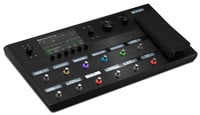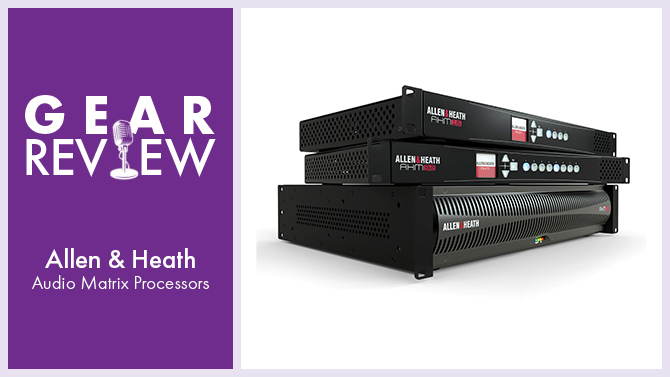The world of guitar tone is changing. While pedalboards with analog Definition:
Definition:
A signal that is continuous in nature, as opposed to being defined as a series of discrete numbers (or elements) as found in digital signals; electrically "analogous" to an acoustical signal in the air. effects remain popular, a new generation Definition:
Definition:
The number of times a recording has been copied. of multi effects like the Kemper Profiling Amp, Line 6 Helix, Boss GT-100, DigiTech RP360XP, Zoom G5N, and others tailor your tone from the first of several effects up to amps and cabinet emulators. You don’t need a traditional guitar amp, because these already provide the sound that amps and cabinets deliver—so what kind of amp do you need?
FRFR (Full Range, Flat Response ) Amplification. The answer is an amplifier Definition:
Definition:
1. A device that increases the voltage or power of a signal. 2. In music performance, a device such as a guitar amplifier that includes speakers and controls to increase the sound level of acoustic or electric instruments. with a flat response, like a PA Definition:
Definition:
(Public Address) A sound system intended to provide audio coverage to large groups of people. system, that doesn’t color the amp’s sound. There are many (many!) powered speakers like the QSC K12.2, JBL SRX815P, Line 6 StageSource L3, Electro-Voice ELX200-12P, Alto Professional TS310, Mackie SRM550, PreSonus StudioLive 328AI, Yamaha DZR10, etc. that are efficient, compact, and deliver clean sound (Fig. 1). However with this many options, it’s not easy to figure out exactly what you need—so let’s look at the specs that matter.

Speaker size. Powered speakers can include one main driver Definition:
Definition:
A system software routine that provides a means of communication between a computer and an associated peripheral (audio interface, hardware controller. etc.). Drivers are updated often for improved efficiency, or compatibility with newer operating systems. (woofer Definition:
Definition:
A low-frequency driver or speaker.), or multiple drivers. Bigger speakers reproduce lower frequencies better, and because guitar goes below 100 Hz Definition:
Definition:
Abbreviation for Hertz. Unit of measurement for frequency, formerly called CPS (Cycles Per Second), that measures periodic waves, audio and radio frequencies, and mechanical repetitive motion. Example: 1000 Hz means a periodic waveform has 1000 cycles/vibrations per second., a 15” speaker is a good choice. However, products with bigger speakers tend to cost more not just because of the speaker, but because of the larger cabinet—so there are practical, financial, and sonic considerations.. Fortunately, a 12” speaker works fine with guitar (think of all the amps with 10” speakers), and even two 8” speakers can be a good choice due to lower cost, a smaller cabinet, and a “tight” sound because smaller speakers can react slightly faster to the output driving the speaker.
For bass, a 15” speaker is usually adequate. But if you want to rattle the floorboards, consider a powered speaker that teams with a complementary subwoofer Definition:
Definition:
A low-frequency speaker, typically optimized for response below 120 Hz, for augmenting full-range sound systems.. Subs are big, though, so finding space in smaller venues—or fitting them into your car—may be tough.
Powered monitors also have high-frequency Definition:
Definition:
A value, expressed in Hertz, that indicates how many cycles of a periodic signal occur in one second. drivers. These aren’t as critical a the woofers, especially because guitar amps don’t have a lot of high-frequency response Definition:
Definition:
The range of frequencies that an audio, video or data device can pass.. The high-frequency driver may be a separate transducer Definition:
Definition:
A device that converts mechanical energy to electrical energy, or vice-versa. For example, microphones, loudspeakers, and guitar pickups are all transducers. , or integrated into a midrange speaker (i.e., a coaxial speaker). If a speaker has a woofer and midrange coaxial speaker Definition:
Definition:
A speaker whose high frequency driver is centered on the same axis as the woofer, to provide true point source imaging., it can legitimately call itself a three-way system (Fig. 2).

Amplifier wattage. You’ll see speakers advertising 1000, 2000, or even more watts. That’s a lot more by tube Definition:
Definition:
(slang) A vacuum tube or (valve), an electronic amplifying or rectifying element with a heating filament, in a glass or metal envelope. guitar amp standards, but these systems are designed to reproduce sound cleanly, which means being able to handle big spikes and transients accurately. You wouldn’t run these full out all the time, as you might with a guitar amp. Pretty much any wattage will fill a typical club; the main advantage of lots of wattage is that when you push it, the sound will still be clean.
Mounting. Most powered monitor Definition:
Definition:
See: Powered Loudspeaker, Active Loudspeaker. can be pole-mounted, but others can mount on the floor, like monitor Definition:
Definition:
1. (audio) A loudspeaker or headphone/earphone used for accurate reference monitoring for recording or broadcast. 2. (live performance) A device that reproduces sound, like an in-ear monitor or speaker wedge, so performers can hear themselves. 3. (computers) A device that provides a graphic representation of operations occurring inside the computer. 4. (video) A device that enables seeing what is occurring with a video shoot, or program material from a broadcast or other video media source. wedges that point up at the performer. Some wedges allow two angles—one facing more up to the performer, and one facing more outwardly. For guitar, this can be more “amp like” if you can angle the wedge Definition:
Definition:
A monitor speaker for performers that sits on the floor, and whose speakers are angled up so that sound waves are localized to the performer. so it faces the audience, and you can stand in front of it.
Daisy-Chaining. When you need more power, some powered speakers have extra connectors so you can “daisy-chain” the signal to additional units for more coverage or higher volume levels.
Other features. We’re now starting to see products that combine both guitar amp and powered speaker characteristics, like the Line 6 FireHawk 1500. Although it’s an FRFR amp, it’s built in a guitar amp-like cabinet and includes modeling options, so you may not need a multi-effects. However if you already have a multi-effects, then all you really need is the powered speaker. But remember that generally, these units are designed for PA applications, so they’ll have features that may or may not matter to instrumentalists (Fig. 3).

- Mic inputs and mic preamps. You don’t need an instrument input, because the multi-effects will provide line level
 Definition:
Definition:
Audio signals around 0.5 volt, ranging from -10dBm to +4dBm. Originally called Telephone Line Level signals. If you’re a singer/songwriter with a stereo Definition:
Definition:
A two channel signal simulating a sound space, typically played through two speakers. source like a multi-effects or keyboard and a microphone, three inputs will take care of you. - Remote control and onboard DSP. For PA applications, it’s great to be able to walk around a room and tune the sound with a smartphone or tablet. For a guitar amp, this may not be as important.
- Class D amplification. Generally, digital
 Definition:
Definition:
A signal or data expressed as series of the digits 0 and 1, typically represented by values of a physical quantity such as voltage or magnetic polarization. amplifiers are more efficient, run cooler, and last longer than analog power amps (although of course, analog amps still work fine). - If you play certain venues consistently, having presets that tailor the sound for each one can be convenient.
- If there’s a fan, make sure it’s low noise. Preferably, it will have variable speed so if not a lot of cooling is needed during that quiet ballad, it won’t make a lot of noise.
- The Yamaha DZR10 offers models equipped with a Dante
 Definition:
Definition:
Dante™ (Digital Audio Network Through Ethernet): The audio-over-IP standard created by Audinate (layer 3). interface Definition:
Definition:
A device that adds I/O capability to another device. Common would be a MIDI, audio or video interface for a computer. for integration with Yamaha consoles and other Dante devices, while the PreSonus StudioLive system can also connect to Dante systems with an optional card Definition:
Definition:
(slang) A circuit board that contains circuitry and plugs into an edge connector. for networking (it also includes a USB Definition:
Definition:
(Universal Serial Bus) A standard, bi-directional serial connection between computers and peripheral devices. Wi-Fi Definition:
Definition:
A wireless network protocol for device networking and internet access. Also spelled WiFi, wifi, or Wifi. module to connect to room control software over a wireless network). Although those options are useful for PA application, they’re probably overkill for an FRFR guitar amp.
Making the switch. If you decide to go FRFR, you’ll probably need to tweak Definition:
Definition:
1. To make minor adjustments. 2. A person who is a perfectionist. your multi-effects. You’re probably used to a certain “tone” from your amp, and it’s unlikely whoever came up with your processor’s presets has the same taste as you (or plays the same guitar). But once you get your collection of sounds with an FRFR setup, you’re set for any FRFR situation—in the studio or live.




























